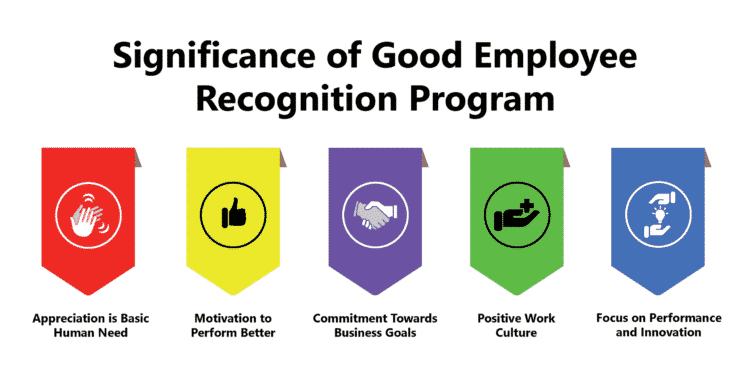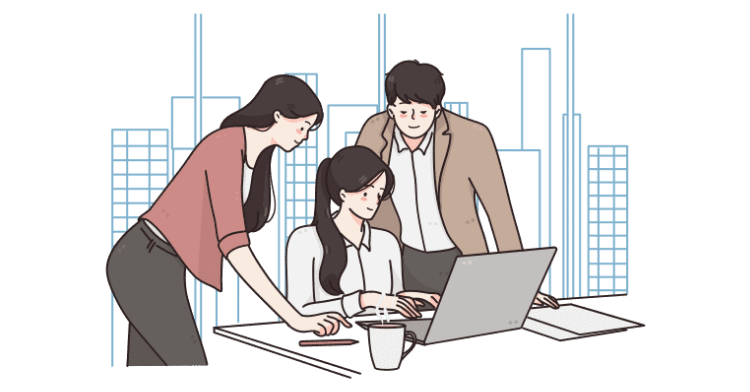1. A good employee recognition program boosts engagement and retention and creates a positive work culture.
2. Key steps include defining clear business objectives, understanding best practices, establishing a robust rewards and recognition policy, and selecting the right technology platform.
3. The program launch should include a well-planned rollout and communication strategy, training key users, tracking program metrics, and regularly reporting performance to top management.
4. Gathering and acting on employee feedback is essential to continuously improve the program and ensure it remains effective and aligned with changing needs and business goals.
Most organizations want a sound recognition system that boosts employee engagement, retention rates, and employer branding. This step-by-step guide on setting up an employee recognition program can help organizations implement a program that delivers excellent results.
1. Appreciation is a Basic Human Need
2. Drives Motivation to Perform Better
3. Increases Commitment towards Business Goals
4. Creates a Positive Work Culture
5. Promotes Performance and Innovation


Being appreciated for their efforts and hard work is a primary human need most employees cherish.
Recognizing employees is about acknowledging their contribution by saying thank you when it matters the most.
Timely acknowledgment and appreciation assure employees that the organization truly values their work.

It in turn, motivates them to keep doing good work and displaying positive behavior.
It also encourages them to perform beyond expectations.

Recognition can make employees feel special and inspire them to put more effort toward fulfilling business goals.

Organizations with effective employee rewards and recognition systems generally boast a positive and productive work environment.
Hence, such work environments naturally motivate employees to contribute their best towards the growth and success of their organizations.

Also, it helps organizations create a culture of high performance, mutual respect, and innovation.
This step-by-step guide to setting up an employee recognition program can help organizations achieve the desired benefits.
Here are the steps, one by one:
1. Define the Business Objectives Clearly
2. Gain a Thorough Understanding of the Best Practices
3. Define Appropriate Rewards and Recognition Policy
4. Decide on the Budget and Get the Approvals
5. Choose the Right Technology Platform
6. Plan the Roll-out and Communication for the Launch
7. Train the Key Users of the Program
8. Track the Program Metrics and Usage Post-launch
9. Report Performance to the Top Management
10. Get Regular Feedback from End-users and Stakeholders
11. Act on the Feedback


Establishing the business objectives is the first important step toward creating a result-oriented employee recognition system.
Hence, it should be well-aligned with the mission, vision, and core values of the organization.
These objectives can help create the framework for the recognition program and enable it to achieve the desired outcomes.
For example, an organization looking to increase and foster employee collaboration should set the objectives accordingly.
It will help the organization consider the recognition strategies focused on fulfilling these objectives.

The next step involves conducting in-depth research about the various best practices in employee recognition.
It can help the organization identify the strategies that would work best in their context.
However, every program needs to meet the specific business objectives, as well as employee needs and expectations.
In most cases, the organization may need to find the best combination of best practices.
For example, peer-to-peer recognition as a practice is growing in popularity.
However, the traditional practice of awards given by the management is also vital for employees.

Defining the right policies for employee recognition helps the organization create a robust framework for executing the system efficiently.
It includes the identification of the different categories of recognition, deciding the eligibility criteria, frequecy and mode for each, and defining the process.
Organizations may reward employees for their performance, behavior, loyalty, and commitment.
Similarly, they must ensure the recognition program sees maximum coverage while remaining aspirational.

Every recognition program should have a well-defined budget based on the organization’s rewards and recognition policies. Management must decide and approve the budget.
To decide on the budget, the organization needs to consider factors such as types of recognition, headcount, employee profile, etc.
However, the organization should understand that an effective recognition program is possible even with a limited budget.
It’s not the budget but the timing and intent of the recognition that matter the most.
Even simple handwritten thank you notes from the CEO as recognition may provide better results than expensive iPads as rewards.

Also, investing in a good employee rewards platform can make the whole process simple and more effective.
Importantly, the technology platform should make the recognition process more convenient and transparent and provide a better employee experience.
It should also reduce the administrative overheads of the HR team involved in managing the program.
It is advisable to choose a platform after considering its compatibility with the recognition policies defined by the organization.
Organizations must consider the platform’s ease of use and integration with social media channels and key IT systems.

Once the employee reward system has been configured and tested, it is time to start planning for the final roll-out.
The organization needs to decide on the launch and communication plan for the program.
The organization should plan the recognition program roll-out with a high-visibility launch campaign or event.
A low-key launch may make the employees feel skeptical about the whole concept from the point of launch.
Phased roll-out may be an option, especially if the workforce is large and geographically distributed.
There should be a series of communications through multiple channels, with the proper involvement of the senior management.

Providing proper training to the key people involved in the recognition program is essential to ensure its successful implementation.
It should include the HR Team, managers, supervisors, and others empowered to nominate employees.
The recognition policy details, recognition categories, eligibility, and key criteria should be part of these training sessions.
It is also vital to ensure that the key participants are comfortable using the recognition platform.

Also, after the program’s launch, tracking usage and other key metrics is paramount.
Hence, the organization needs to monitor program performance vis-à-vis its objectives to see if it is driving the right results.
The organization must also measure the program’s impact on employee engagement, satisfaction, workplace happiness, efficiency, and performance improvement metrics.
However, it is essential to measure and analyze the critical program metrics over time and take corrective action to ensure their success.

In addition to capturing the critical program performance metrics, these must be reported to top management regularly.
The management needs to review the impact of the program and the returns on investment in launching the program.
HR must convince management that the program delivers the expected results and get approval to continue or increase funding.
They may also ask HR to review the program design or revamp it entirely for better results.

It is essential to get regular feedback from all end-users about their overall experience of the program and its nuances.
Such feedback provides vital inputs for making changes in the recognition policy framework, process, or system.
The organization can use various methods to seek employee feedback about the recognition program.
They can use online feedback surveys and interactive feedback sessions to collect employee feedback.

Carefully analyze the data collected through employee feedback to find the most common and critical grievances against the program.
After identifying the key issues, the organization needs to find the best ways to resolve them.
So, it is crucial to understand that employee needs and business realities change over time, impacting the effectiveness of a program designed years ago.
Hence, by implementing the necessary changes, the organization can build a truly efficient, engaging, and result-oriented rewards and recognition program.
This step-by-step guide on how to set up an employee recognition program is based on best practices from organizations that have successfully implemented employee recognition programs. It can help build a recognition-driven organization culture that promotes innovation, performance and business growth.

Lead author: Sagar Chaudhuri, the Co-Founder and CEO of HiFives. He is an HR Tech Evangelist with over 25 years of corporate and entrepreneurship experience. In the past, Sagar has worked in leadership roles with companies such as Genpact, Infosys, and ICICI Bank. He has an engineering degree from IIT Kharagpur and an MBA from IIM Lucknow. Connect on LinkedIn
To stay updated on the latest HiFives blogs, follow us on Twitter (@MyHiFives)